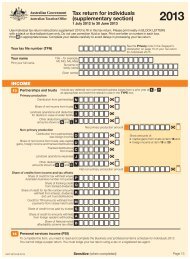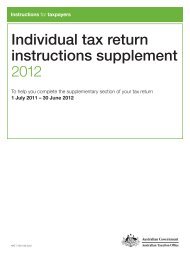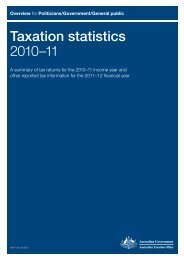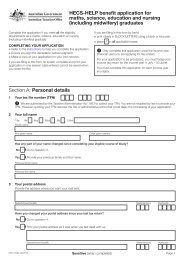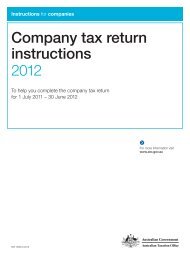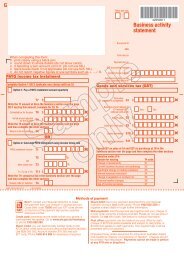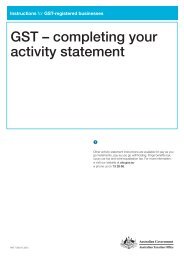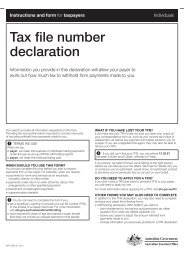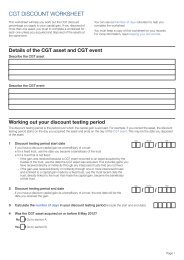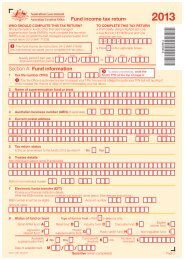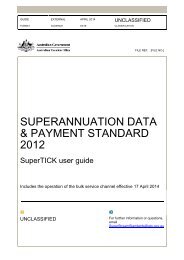Guide to depreciating assets 2013 - Australian Taxation Office
Guide to depreciating assets 2013 - Australian Taxation Office
Guide to depreciating assets 2013 - Australian Taxation Office
Create successful ePaper yourself
Turn your PDF publications into a flip-book with our unique Google optimized e-Paper software.
The opening adjustable value of an asset for an income yearis generally the same as its adjustable value at the end of theprevious income year.Balancing adjustment amount: The balancing adjustmentamount is the difference between the termination value andthe adjustable value of a <strong>depreciating</strong> asset at the time of abalancing adjustment event.If an asset’s termination value is greater than its adjustablevalue, the difference is generally an assessable balancingadjustment amount.If the termination value is less than the adjustablevalue, the difference is generally a deductible balancingadjustment amount.Balancing adjustment event: Generally, a balancingadjustment event occurs for a <strong>depreciating</strong> asset if you s<strong>to</strong>pholding it (for example, if you sell it) or you s<strong>to</strong>p using it andyou expect never <strong>to</strong> use it again.Car limit: If the first element of cost of a car exceeds the carlimit for the financial year in which you start <strong>to</strong> hold it, that firstelement of cost is generally reduced <strong>to</strong> the car limit. The carlimit for 2012–13 is $57,466.Decline in value: Deductions for the cost of a <strong>depreciating</strong>asset are based on the decline in value.For most <strong>depreciating</strong> <strong>assets</strong>, you have the choice of twomethods <strong>to</strong> work out the decline in value of a <strong>depreciating</strong>asset: the prime cost method or the diminishing value method;see Methods of working out decline in value on page 6.Depreciating asset: A <strong>depreciating</strong> asset is an asset thathas a limited effective life and can reasonably be expected<strong>to</strong> decline in value over the time it is used.Some <strong>assets</strong> are specifically excluded from the definitionof <strong>depreciating</strong> asset; see What is a <strong>depreciating</strong> asset?on page 3.Effective life: Generally, the effective life of a <strong>depreciating</strong>asset is how long it can be used by any entity for a taxablepurpose or for the purpose of producing exempt income ornon-assessable non-exempt income:n having regard <strong>to</strong> the wear and tear from your expectedcircumstances of usen assuming it will be maintained in reasonably good orderand condition, andn having regard <strong>to</strong> the period within which it is likely <strong>to</strong> bescrapped, sold for no more than scrap value or abandoned.First element of cost: The first element of cost is, broadly, theamount paid (money or the market value of property given) orthe amount taken <strong>to</strong> have been paid <strong>to</strong> hold the asset. It alsoincludes amounts incurred after 30 June 2005 that are taken<strong>to</strong> have been paid for starting <strong>to</strong> hold the asset. The amountsmust be directly connected with holding the asset.Holder: Only a holder of a <strong>depreciating</strong> asset may deductan amount for its decline in value. In most cases, the legalowner of a <strong>depreciating</strong> asset will be its holder; see Who canclaim deductions for the decline in value of a <strong>depreciating</strong>asset? on page 4.Indexation: Indexation is a methodology used in calculatinga cost for capital gains tax for <strong>depreciating</strong> <strong>assets</strong> acquiredbefore 21 September 1999 that have been used partly fora private purpose.Second element of cost: The second element of cost is,broadly, the amount paid (money or the market value ofproperty given) or the amount taken <strong>to</strong> have been paid <strong>to</strong>bring the asset <strong>to</strong> its present condition and location at anytime, such as the cost incurred <strong>to</strong> improve the asset. It alsoincludes expenses incurred after 30 June 2005 on a balancingadjustment event occurring for the asset, such as advertisingor commission expenses.Start time: A <strong>depreciating</strong> asset’s start time is generallywhen you first use it (or install it ready for use) for any purpose,including a private purpose.Taxable purpose: A taxable purpose is the purpose ofproducing assessable income, the purpose of explorationor prospecting, the purpose of mining site rehabilitation, orenvironmental protection activities.Termination value: Generally, the termination value is whatyou receive or are taken <strong>to</strong> receive for an asset as a resul<strong>to</strong>f a balancing adjustment event, such as the proceeds fromselling an asset.GUIDELINES FOR USING THEDEPRECIATING ASSETS WORKSHEETThe <strong>depreciating</strong> <strong>assets</strong> worksheet is on page 39.Primary production only and Non-primary production only:Use a separate worksheet for each category.Cost: The cost of a <strong>depreciating</strong> asset includes the first andsecond elements of cost. You must adjust the cost of an assetin certain circumstances, such as when the first element of acar’s cost exceeds the car limit. If you have adjusted the cos<strong>to</strong>f the asset, include the adjusted cost in this column; see Thecost of a <strong>depreciating</strong> asset on page 14.Opening adjustable value and Adjustable value at end ofyear: The adjustable value of a <strong>depreciating</strong> asset at any timeis its cost reduced by any decline in value up <strong>to</strong> that time.The opening adjustable value of an asset for an income yearis generally the same as its adjustable value at the end of theprevious income year.Balancing adjustment events: Generally, a balancingadjustment event occurs for a <strong>depreciating</strong> asset when yous<strong>to</strong>p holding it (for example, if you sell it) or when you s<strong>to</strong>pusing it and you expect never <strong>to</strong> use it again; see Whathappens if you no longer hold or use a <strong>depreciating</strong>asset? on page 17.Termination value: Generally, the termination value is what youreceive or are taken <strong>to</strong> have received for the asset as a resul<strong>to</strong>f a balancing adjustment event, such as the proceeds fromselling the asset; see Termination value on page 18.Balancing adjustment amounts: If the asset’s terminationvalue is greater than its adjustable value, the excess isgenerally an assessable balancing adjustment amount. If thetermination value is less than the adjustable value, the differenceis a deductible balancing adjustment amount. If you use theasset for a non-taxable purpose, you reduce the balancingadjustment amount and a capital gain or capital loss may arise;see Depreciating asset used for a non-taxable purposeon page 19.Balancing adjustment relief: This refers <strong>to</strong> the offsettingof otherwise assessable balancing adjustment amountsfor involuntary disposals (see Involuntary disposal ofa <strong>depreciating</strong> asset on page 21) or when rollover reliefapplies; see Rollover relief on page 21.36 a<strong>to</strong>.gov.au GUIDE TO DEPRECIATING ASSETS <strong>2013</strong>



